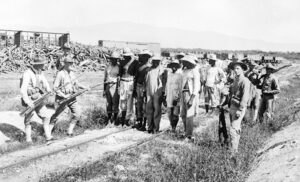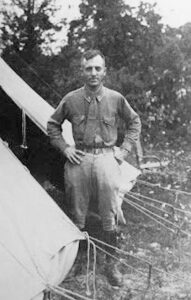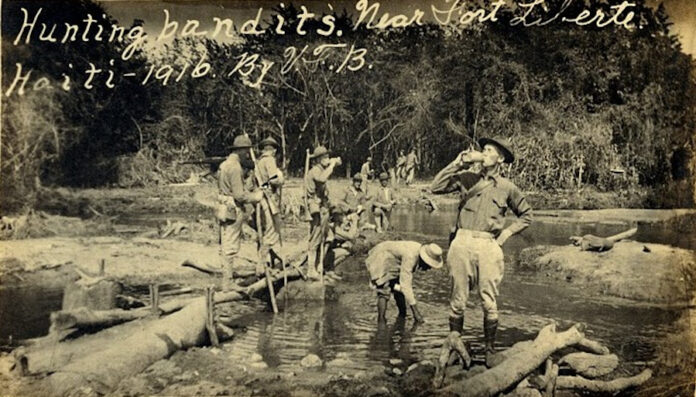The third of three articles
(Part 1) (Part 2)
By mid-October 1915, enough villages had been burned, bribes distributed, and Cacos arrested or killed that the Americans were in control of Haiti’s northern coast. The Marines pushed farther into the mountains of the Massif du Nord. The summits are among the highest in a country whose name comes from the Taino for “mountainous place.” Their nigh-impenetrable terrain had made those highlands the strongholds of Haitian independence fighters for over a century.
On the way, Butler wrote a letter to his youngest son, Tom Dick. The boy’s second birthday was a few weeks away, but Smedley knew he likely would not have time to write then. “Thy father has been and will be quite busy for some time attending to his duties, the vast majority of which are causing him much discomfort, but he is doing all in his best style, so that when thee and thy Precious Sister and Big Brother grow up you will have no reason ever to be ashamed of him,” he wrote. Waller, Smedley noted for Bunny’s benefit, had authorized him to “go wherever and do whatever I please” in his mission to crush the Cacos.
On Oct. 24, Butler led 38 Marines on horseback out of the city of Fort-Liberté in search of a Caco stronghold. At dusk, while the Marines were fording a river near the village of Bahon, the hills echoed with the trumpeting of conch shells. The Cacos opened fire. Only the inaccuracy of the Cacos’ antiquated rifles, and the Marines’ tactical use of their horses as shields, kept Butler and the rest of the platoon from being killed in the water. The Marines fought their way to a protected position, at the cost of a dozen horses and the mule carrying the platoon’s lone machine gun. Butler’s gunnery sergeant, Dan Daly — the short, wiry son of an Irish immigrant factory worker on Long Island — made his way back to the river, knifing several Cacos on the way. Daly cut the machine gun and ammunition off the dead mule, and brought the 200-pound load back to the platoon. At dawn, the Marines “hunted the Cacos down like pigs,” Butler later wrote.

Over the following weeks, the Marines continued driving the Cacos back through the mountains. As of Nov. 1, Smedley wrote Bunny, “I have marched 270 miles and ridden horseback 50 miles — total 320 miles in 43 days.” He expected to double that by the middle of the month by “patrolling and reconnoitering the surrounding country trying to sweep it clear of Cacos” — “but,” he cautioned, “they are as hard to catch as fleas.”
That was by design. The Cacos were heirs to a tradition of resistance that dated back to guerrilla fighters in the Haitian Revolution. They took their name from a native cuckoo bird that hides in the bush before striking at its prey. In the 19th century, farmers fighting under the Caco name rebelled against Haitian elites who, unable to imagine another way to generate wealth, tried to force them back onto plantations under the cover of the so-called corvée — a medieval French term for forced labor. Recognizing the corvée as slavery by another name, these earlier generations of Cacos had overthrown every attempt at implementing it at scale. In that sense, it had been the guerrilla Cacos, not the Haitian state, who had been the guarantors of the Haitian promise of freedom.
Using their knowledge of the terrain and skills of attacking and retreating, the Cacos drove Butler and the Marines to their wits’ end. On one raid, the Americans stormed Fort Capois, the supposed stronghold of Josaphat Jean-Joseph — a Haitian army veteran turned Caco commander of the region of Grande-Rivière-du-Nord. But when they fought their way into the main fort, they found no one inside. “There was evidence of blood in many places, but no dead or wounded,” Capt. Chandler Campbell reported. Jean-Joseph’s garrison had escaped up the mountain, using secret trails the Marines hadn’t known about, apparently carrying their casualties with them.
Reconnaissance patrols eventually located their hiding spot: 3,600 feet up a mountain above Bahon, in an old star-shaped redoubt called Fort Rivière. In a series of limited assaults, the Marines closed off all obvious escape routes. After midnight on Nov. 17, 1915, three Marine companies and two Navy bluejacket detachments assembled on the three sides of the mountain and began climbing toward Fort Rivière.
Butler led Fifth Company from the west. They climbed through the night over the steep trails. As they gained altitude, the heavy tropical air grew cold and thin. The Marines took extra care to ensure the mules carrying their Benét-Mercié M1909 machine guns did not slip and fall off the side.

Near the top, the last of the vegetation disappeared, giving way to scattered boulders. There would be nowhere to hide when the fighting began.
As the sun rose over what the locals called Montay Nwa — black mountain — the brown brick parapets of Fort Rivière were still just out of view. From the western slope, Butler and his men could look straight down into the Citadelle Laferrière. That monumental fortress, perched on a lower peak, had been the jewel of a nationwide system of mountaintop forts meant for a desperate last-ditch defensive strategy: if the French or another slaving power reinvaded, Haitians would burn their cities and take refuge on the mountaintops, where they would make good on their motto: libète ou lanmò — liberty or death.
At 7:50 a.m., Campbell blew a whistle, and the Marines let loose a storm of automatic fire. Butler’s column scrambled over the last ridge and rushed forward under heavy fire from the Cacos, only to find that the main entrance to the fort had been sealed. Then Butler spotted a small breach: “a drain four feet high and three feet wide extending back for 15 feet into the interior.”
Sgt. Ross Iams forced himself into the opening first, followed by Butler’s orderly, Pvt. Samuel Gross. Butler entered third. (“I had never experienced a keener desire to be someplace else,” he later said.) He squeezed his way through the narrow space, deafened by echoes of gunfire pinging off the walls, and emerged in the middle of an open brawl. Cacos were shouting:
“Touye yo!” (Kill them!) Butler fired his pistol at a Caco charging toward him and missed. He was saved, a heartbeat later, by a better shot from Gross. The three Marines got off as many rounds as they could as more Americans climbed out of the drain, one by one.
For 10 minutes, Marines and Cacos fought to the death inside the mountaintop fort, until the dirt floor was muddied with blood. Some of the Cacos, their antiquated rifles useless at close range, resorted to rocks and sticks. Realizing they were outgunned, the surviving resistance fighters tried to escape. Butler watched with both horror and relief as they climbed and leaped off the parapets, only to be mowed down as they fell by Campbell’s machine gunners, who had been lying in wait.
Two days later, a small group of Marines climbed back up the mountain and dynamited the interior of the fort, Haitian bodies and all.
In the century since the slaughter, Fort Rivière was largely forgotten by Haitians and Americans alike. In 1931, a Haitian ambassador — perhaps embarrassed by the stories of such a catastrophic defeat — went so far as to deny that the remote mountain stronghold had ever existed, resulting in a public argument with Marine veterans of the battle in the press.
One person who could not forget the battle was Butler. A few weeks after the massacre, Smedley had confided to Bunny: “The past several weeks seem like a horrible nightmare, such terrible work and such terrific excitement.” He went on: “Of course at the time I thought it fine, but looking back at it the sight is not a desirable one — particularly those awfully shattered bodies at Fort Rivière.” Over the coming months and years, the gravity of what he had done would only weigh more heavily on him.
(From Gangsters of Capitalism by Jonathan Katz. Copyright © 2022 by the author. All rights reserved. Click here to order the book.)











As a fellow Haitian, this hurt. I know there’s a God and he will deal with those scums.
That monster killed thousands of Haitians in one day who was living peaceful in their native land…the writer fail to mention that because t’ ill this day Hayiti is Paying for that…Nazism and Fascism is ongoing around the world and people are dying every day because of the West thirst for other people sheet…but if there is justice i know the law of nature will prevail for that i know…Long live Papa Dessalines…your sons and daughters shall gain the battle.
With all due respect to Haitians living in the Diaspora : They had contributed to the long going Astrocities commits by U.S and France , Canada , Spain , Germany ! Today look out the behaviour of the Haitians Diaspora .
Their deals as Sealed with the International , they are collecting different passports over the Haitian Passport like Birth Certificate, not as a bridge to the International . After 1987 again U.S and his Gangsters Sabotaging 2004 Independence, There’s a Koutyè , a Tschoul name Andrè Apaid who has a Coalition of local Gangsters with Arabs , Israel , Spain , U.S , Canadian Ties overthrown Aristide, and collected the Country Treasures and Promises Rice to the Locals to brainwashed them against Aristide : Since then Haiti has been only sanking under U.S and the World Ambargo , World Media Non Stop Defamations , Turn the World against Haiti , Only Cuba , Venezuela and Jamaica doesn’t jump in the Haiti Isolations and Destructions by the Internationals.
There’s so many Cruelty Towards Haiti : Haitians Doesn’t Retaliate Like Ben Laden Did , As Such Reactions from Haitians Would have been the well Right Reaction , Unfortunately !!! They are not related to their Anscestors , because so much and too much programmed Destructions towards them , should have empowered them to finally see clearly , it is them against the World !!! Excluded Cuba , Jamaica and Venezuela and the Whole Africa.
Haiti has no other friends : Haitians Need To Stop Loving Guest Country’s More Then Their Country, every investment a Haitian made in those guest Country’s should have had diverted positive impact towards their Country’s, Mortgages, Bank Accounts, What type of Degrees they are collecting from the University ‘s abroad Etc.
Haitians are the only Nation on earth who really have monopole on Pride : no others achieves that longitude of anything close , Because the World Knows Their Strenght and Capability’s ! The Animalistic World leeds by those Country’s Doom Haiti and his people : Africans , Indians , Mulattoes , Tomatoes are all Tribes under the Haitians Flag.
I agree 100% with those who are not afraid to speak up how the imperialist destroyed and they are still doing it to the present day. They are the ones created the gangs in Haiti so we can kill each other like hugo cahvez once said if the US don’t want to cooperate with a president because they that particular president wants to do good for their country but they would rather deal with a puppet and a corrupted to steal our resources and love to call us poor countries and most felt for it and trying every day to get a visa to come to the American dreams but if they you in is to make their economy grow better the always use the slogan God bless America but fuck the other countries….
It took us 300 plus years to kick the French’s out.I believe when the time comes we will be strong,unify and we will prevail all the…….
I love my country that I love so much for 40 years now my mother 88 years tells me don’t even come if she dies because Port-au-Prince where I was born is…..
Ayiti is a mysterious country we will surprise the the world like we did before.
Till this day. Haiti is still going through the same stuff by the U.S, Accept their do it in a more modern style, using a few wicked Haitian leaders to get their ways. Such criminal like ariel henry and his entourage. Just like in 1915 led by back than the U.S. president Woodrow Wilson who invaded Haiti killed thousands of Haitian citizens including their president. Occupied the country for 19 years. Stole our resources including breaking into our national bank stolen gold that’s worth millions of dollars.U.S will paid a big price one day for how they contributing to everything that my country went through, and still going through to this day. I don’t know who’s going to make them paid for it. But I’m praying for this day to come.
U.S is known for that
In 1915 U.S invaded Haiti, killing thousands of Haitian military and Haitian citizens. Led by back than U.S. president Woodrow Wilson Breaking into our national bank stealing millions of dollars worth of gold, our resources destroyed and occupied the country for 19 years. Haiti is still going through the same stuff. Accept in a more modern style. Using wicked Haitian politicians such as ariel henry and his evil entourage. Creating gangs to terrorize The population. I believe one day the U.S.will paid for their evil ways. I don’t know by whom. But they will pay a major price.